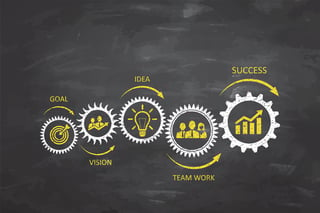Growth Insights for CEOs
Paul Sparrow
/CMO-Paul-Sparrow.jpg?width=320&name=CMO-Paul-Sparrow.jpg)
Recent Posts

AI Search is Here – And it’s Reshaping the Buyer Journey
Part 1 of our four-part series exploring how AI search is transforming visibility, SEO, and digital strategy - and what CEOs need to do now to stay competitive.
| Executive Takeaways |
| Declining web traffic isn’t random - it’s a symptom of changing search behavior. AI search is already impacting over 25% of user journeys - and growing fast If you’re not being cited, you’re missing opportunities-period. |
Recent Posts

The Entrepreneur’s Growth Playbook
Thu, Apr 22, 2021 — Blog 1: Are You a Pioneer or a Settler? Six Steps to a Better Business Model Written by: Paul Sparrow, Area Managing Partner & CMO, Chief Outsiders with Samuel Kniseley Ballesteros of The Advantage Solution and a Professional EOS Implementer Take a trip with us, if you will, back to Northern California in 1849. Word has spread across the land – there’s gold in them there hills, and we need to go find it. On just this pronouncement, and with not much more than hope and a promise, pioneers set forth to go find the gold – and with it, riches beyond their wildest imagination. You know the rest of the story – some of these folks went boom, most went bust, and the California Gold Rush became a literal flash in the pan.

Innovation, Part 2: Finding the Discipline Needed to Reinvent and Reinvest
Thu, Jan 28, 2021 — What does it take to be a change agent in a world that doesn’t stop changing? My last blog on change and innovation referenced Billy Joel, and you may recall his song, “We Didn’t Start the Fire,” essentially a history lesson of the 1940s through 1980s in three minutes. If we asked The Piano Man to write a tune forecasting the 2020s, it would likely last an hour – and still not cover everything.

Innovation, With a Purpose: Use 2020 as a Springboard for Change
Fri, Jan 22, 2021 — Alas, it was many moons ago that one of my favorite musical artists, Billy Joel, sang those insightful words: “Don’t go changing to try and please me.” No matter how eloquent or visionary he might be, the “Bard of Brooklyn” couldn’t have foreseen that a pandemic would all but mandate change as a means of business survival. Now we must all go changing, to try and please EVERYONE. Fueled by the ongoing digital revolution, lockdowns, economic turmoil, and a global financial shakeout, we can generally agree that the tried and true has given way to the untried, and new.
Stay up-to-date with the latest from Chief Outsiders

Your Sales and Marketing Pros Are At Odds – Here’s How to Get Them Aligned
Thu, Dec 3, 2020 — Since the era of cavemen, the roles of Sales and Marketing professionals have been fairly well defined. The earliest marketers would create awareness for that remarkable new invention, the wheel; and the salespeople would roll it down the streets, sharing the features and benefits to interested customers, then collect five dodo-birds in compensation. In the million years since, Sales and Marketing departments still have a similarly symbiotic existence -- but a lot seems to have changed in the digital era. Today, the gap between Sales and Marketing represents a gray area at most companies — from the smallest distributors, to the largest multinational enterprises.

Executing Through Economic Challenges: Part Three
Wed, Sep 16, 2020 — Capital Considerations of COVID As a business owner who has planned and prepared your company to survive dips in demand, little could have braced you for the Grand Canyon-sized maw that opened when the coronavirus struck this spring. The journey back from the challenges of pandemic gloom, for many, has required a type of mettle that we never thought we had. If you’ve tuned in to the two earlier segments of this series, you have understood that the climb back to the rim of the canyon requires a commitment to execution, insights, and empathy, as well as gauging the economic health of your organization.

Executing Through Economic Challenges: Part Two
Mon, Sep 14, 2020 — Gauging Your Economic Health As a business owner in 2020, there are two words that would likely strike fear in your heart – and they are not “global pandemic.” “How’s business?” has become the couplet most reviled by many CEOs – including those who traditionally answer that query with a smile, thumbs up, and hearty laugh. The coronavirus has indeed transformed the outlook for many businesses, and in my previous blog we discussed the critical importance of execution, perspective, and empathy in withstanding the challenges that continue to lap at our doorstep.

Executing Through Economic Challenges: Part One
Wed, Sep 9, 2020 — Shake Off the Shock-and-Awe Hardly anyone wants to hear it—it’s all so obvious—but the grim reality is front and center, so I’ll step up and say it. Nothing has torpedoed the U.S. economic growth engine like COVID-19. All at once, business ground to a halt back in March 2020 and we’ve all been grinding the gears and cycling the starter ever since, in a desperate bid to spark a restart. The desire to revive the revenue machinery has caused many businesses to tear up the playbook, toss out the strategic plan, and feed the engine whatever fuel they can get their hands on.

The Reopening Playbook — Real Strategies to Succeed Right Now in Today’s Marketplace
Mon, Jul 6, 2020 — Unless you are reading this blog from the Marshall Islands, Samoa, or about 10 other remote archipelagos, you likely have been impacted by the COVID-19 pandemic. And my guess is you’re sick of reading introductions like, “In light of these trying times,” or “We’re all in this together.” Chances are as a company owner/CEO, you feel quite like you’re in this all by yourself. After all—it’s lonely at the top. So, a few practical tips to move your business through the hiccups and return to healthy growth might be helpful. In the next five to seven minutes, I hope to help jumpstart your current and post-COVID playbook. One prerequisite: Take a look at my previous blog about dealing with changes in the economy - in particular, the section that helps you assess what phase of growth your company finds itself in as you prepare to “reopen.”

Can Your Business Thrive Despite Changes in the Economy? Part 2
Wed, Feb 26, 2020 — Time to Hide or Double Down? Riding the 2020 Wave Establishing order in the midst of chaos can be most elusive, wouldn’t you agree? Just ask poor Chip Diller, the do-gooder ROTC cadet portrayed by Kevin Bacon in the seminal college movie classic, “Animal House.” Surrounded by fleeing masses in a parade gone wrong, and about to be bulldozed by a stampeding crowd, Diller thrusts out his hands and, gathering as much gravitas as possible, shouts, “Remain calm. All is well!” before he’s swarmed by the crowd and trampled into a facsimile of “Flat Stanley.”
.png?width=1500&height=398&name=CO_Corporate%20Logo%202021_4C_HOR_FNL-1%20(1).png)